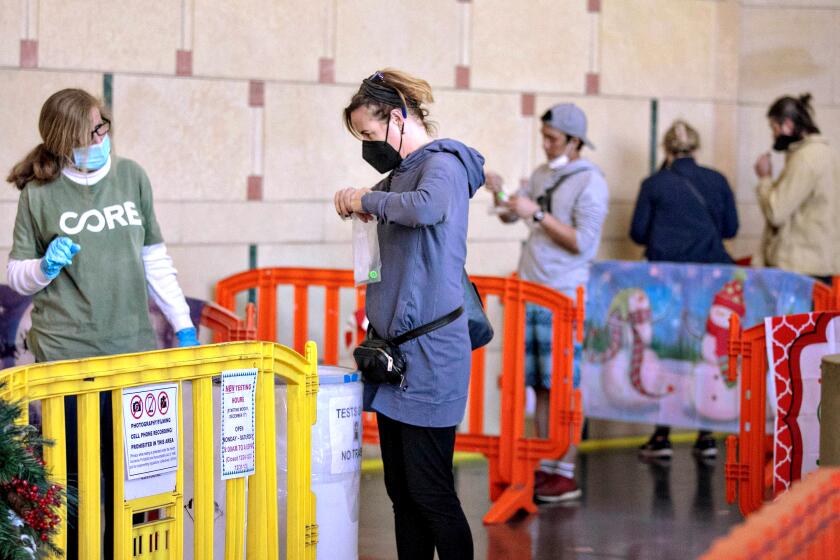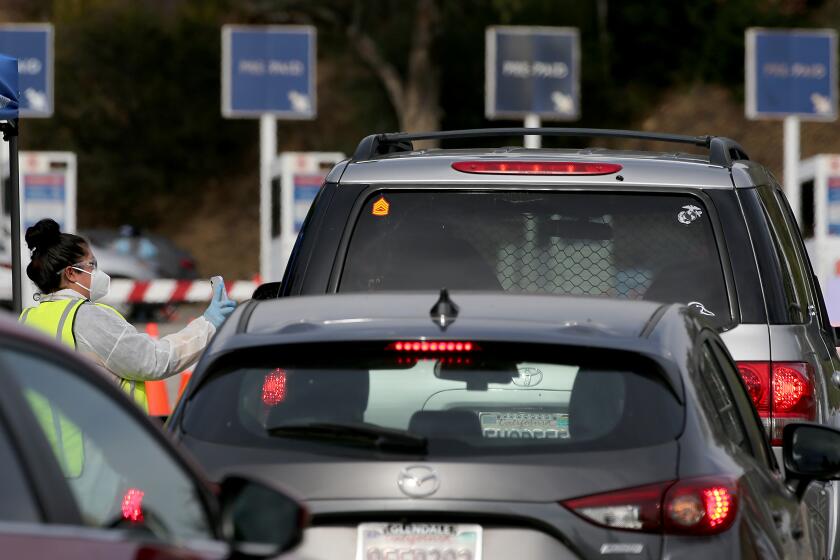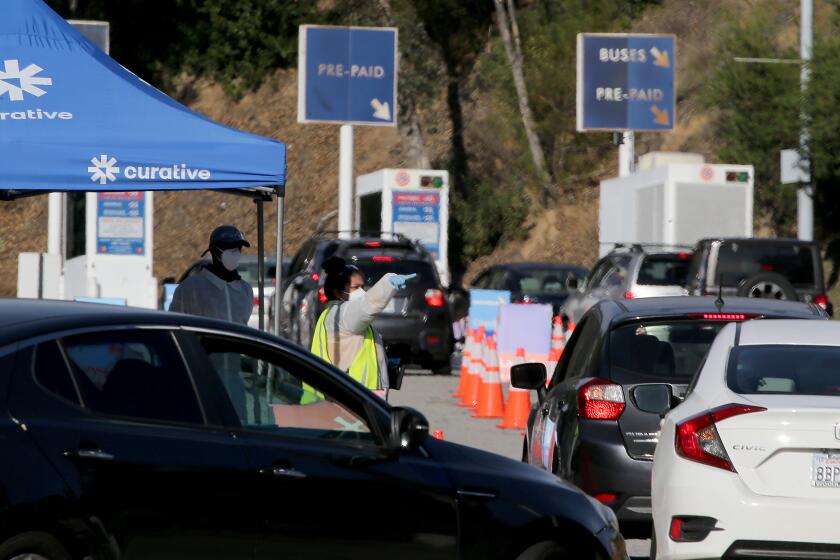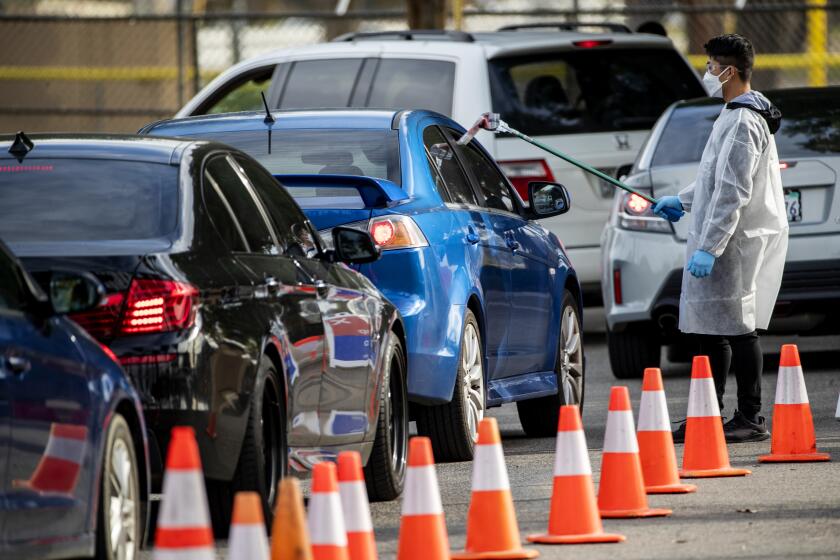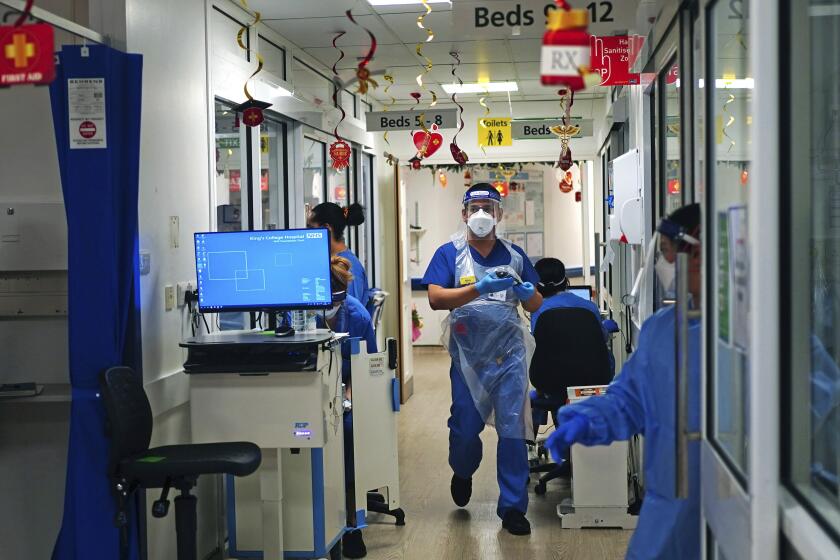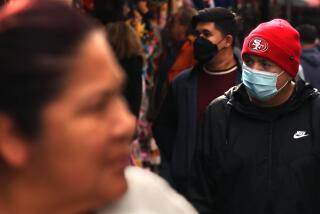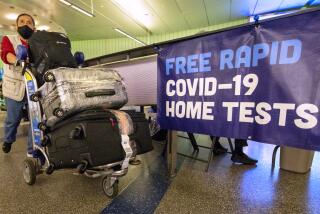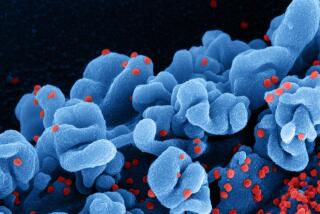Omicron becoming dominant in some parts of California as COVID-19 cases soar
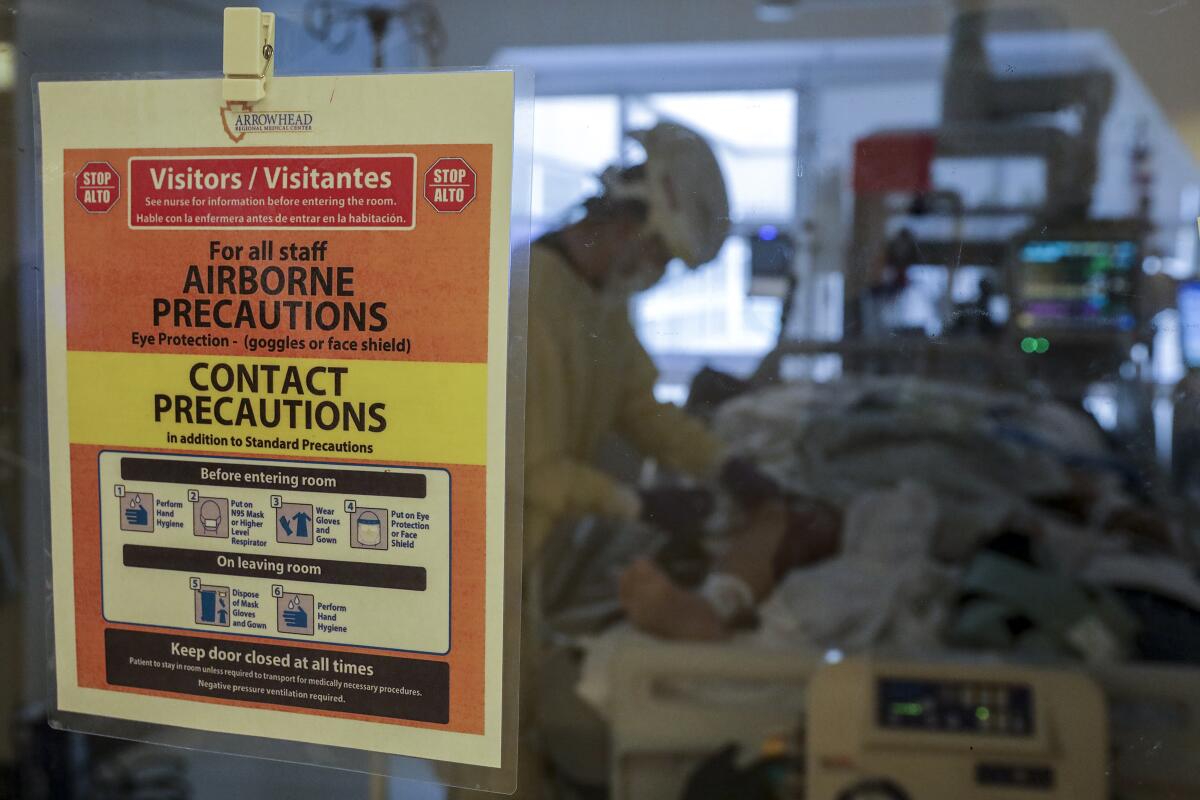
- Share via
Omicron is now the most identified variant of the coronavirus in some parts of California, officials said Thursday, marking a stunning rise that has triggered a new surge of infections, cast fresh uncertainty on holiday plans and prompted additional measures aimed at checking the strain’s rapid spread.
According to data released Thursday by the California Department of Public Health, at least three California health systems have reported that Omicron appears to account for 50% to 70% of new cases. Officials stressed that full sequencing of the cases is still being done and did not identify the areas where Omicron was spreading fastest. Additionally, the state said, clinical and wastewater data suggest Omicron is now spreading in most parts of California.
Daily reported coronavirus cases are soaring in Los Angeles County as the region grapples with the early effects of a new surge fueled by the highly mutated Omicron variant.
A day after reporting 6,509 new coronavirus cases — which was more than twice the figure from the day before — county health officials reported an even higher infection total Thursday: 8,633.
“This steep increase, one of the steepest rises we’ve ever seen over the course of the pandemic, reflects the increased circulation of Omicron and the associated rapid acceleration of transmission associated with this variant,” county Public Health Director Barbara Ferrer said Wednesday.
And the surge isn’t just in L.A. In San Francisco, public health officials said the local case rate has tripled, which they called “a clear indication that we have entered the fifth surge in the pandemic.”
“Omicron is rapidly spreading, and all evidence points to the fact that we need to do more to protect ourselves and others from infection,” Dr. Grant Colfax, San Francisco’s director of health, said in a statement Thursday. “Boosters are key right now for your own protection and those you love. We also want people to celebrate the holidays more safely and with an extra dose of caution.”
California’s winter COVID-19 surge intensified Wednesday, with new overall coronavirus cases likely tied to holiday gatherings spiking up, along with confirmed cases of the Omicron strain.
On Monday, federal health officials said the Omicron variant was now the dominant version of the coronavirus nationwide, accounting for an estimated 73% of new infections last week.
“Due to Omicron, we expect a significant rise in cases,” said Jeff Zients, President Biden’s COVID-19 task force coordinator. “Fully vaccinated people, particularly those with a boost, are highly protected. But due to Omicron’s highly transmissible nature, we will see fully vaccinated people get COVID. They’ll likely be asymptomatic or feel under the weather for a few days. Let’s be clear: Unvaccinated people are at a higher risk of getting severely ill from COVID, getting hospitalized and dying.”
Gov. Gavin Newsom foreshadowed a similar development in California during a briefing Wednesday, saying, “We now are tracking well north of 50% of all of the sequenced genomes” being identified as Omicron.
While scientists are still racing to understand the full impact of the variant, the best lines of defense remain familiar: “Get vaccinated; get boosted; wear a mask in public indoor settings in areas of substantial and high-risk community transmission; and take a test before you gather,” said Dr. Rochelle Walensky, director of the U.S. Centers for Disease Control and Prevention.
Testing, however, has been difficult for some. Recent heavy demand has left residents facing empty store shelves or contending with long lines at screening sites.
A winter storm that blew into the Southland on Thursday further exacerbated the problem, forcing some testing and vaccine sites to head indoors or close.
Ahead of the holiday weekend and amid a surge of coronavirus cases, a storm forces some coronavirus testing and vaccine sites to head indoors or close.
California officials have said they are prepared to see an uptick in cases linked with Omicron and have announced measures aimed at helping the state against a wintertime resurgence.
Those include a statewide mask mandate for indoor public spaces and a requirement for workers in healthcare and high-risk congregate settings to get a booster vaccine dose, as well as plans to provide rapid tests for students in K-12 public schools and expand hours at busy screening sites.
Over the weeklong period ending Thursday morning, California reported an average of 9,674 new coronavirus cases per day — a 37% increase from two weeks ago, according to data compiled by The Times.
COVID-19 hospitalizations have also ticked up, albeit at a slower rate. The number of coronavirus-positive patients statewide Wednesday, 3,622, is up about 6.5% from two weeks ago.
More than 6,500 new infections were reported Wednesday, more than double the previous day’s tally.
Deaths have remained relatively flat over that same time. An average of 72 Californians have died from COVID-19 each day over the last week.
In earlier waves, officials noted a consistent cadence of the pandemic — with increases in cases triggering corresponding rises in hospitalizations about two weeks later and then deaths a few weeks after that.
Hence, the full ramifications of Omicron’s recent spread are still to be felt.
“While many will be protected in this round against the most severe illness from Omicron because they are fully vaccinated and they’re boosted where eligible, very high case numbers can easily cause significant stress to our healthcare system,” Ferrer said.
However, there are promising indications that the variant — though highly infectious — may cause less-severe symptoms.
Early data from England, Scotland, Denmark and South Africa suggest that an Omicron infection resulted in a 40% to 70% reduced need for hospitalization compared with the Delta variant.
There’s also no evidence that people who are vaccinated and have received a booster shot are getting severely ill with Omicron, unless they have a significantly weakened immune system.
The prospect of a variant that spreads easily, but causes largely mild disease, has been met with optimism in some corners.
Early research points to mutations in the spike protein. But much remains unknown or unconfirmed.
“Would it be preferable to have Omicron be totally pervasive and be relatively low degree of severity? Yes, obviously, that would be preferable,” said Dr. Anthony Fauci, Biden’s chief medical advisor.
But, he added during a briefing Wednesday, “it’s dangerous business to be able to rely on what you perceive as a lower degree of severity.”
“You can’t count on anything when you’re dealing with a virus that has fooled us so many times before,” Fauci said.
Here’s what scientists are watching for as they gauge what Omicron has in store for us this winter.
There’s also a mathematical reality that comes into play. Omicron’s ultra-contagious nature means an extraordinarily high number of people could get infected in a short time.
And even if a lower percentage needs hospital care, a high number of infections happening at once could strain hospital systems, particularly in areas where vaccination rates are low.
“The problem is a numbers problem,” Ferrer said. “So if Omicron causes less severe illness but it infects many more people, then even if you have a smaller number of the people who are infected get severe illness, you could still end up with overwhelming numbers.”
Times staff writer Rong-Gong Lin II contributed to this report.
More to Read
Sign up for Essential California
The most important California stories and recommendations in your inbox every morning.
You may occasionally receive promotional content from the Los Angeles Times.
